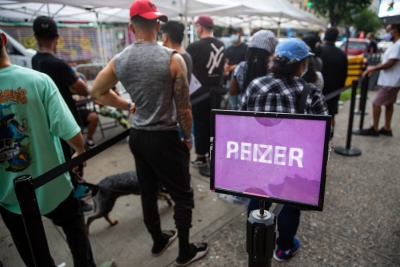NEW YORK– Pfizer Inc. (NYSE:PFE) today announced that the U.S. Food and Drug Administration (FDA) accepted for review a Biologics License Application (BLA) for its investigational pentavalent meningococcal vaccine candidate (MenABCWY). Pfizer submitted MenABCWY for the prevention of meningococcal disease caused by the most common serogroups in individuals 10 through 25 years of age.
The Prescription Drug User Fee Act (PDUFA) goal date for a decision by the FDA on the pentavalent meningococcal vaccine application is in October 2023.
Pfizer’s MenABCWY vaccine candidate combines the components of two vaccines into one, helping protect against the meningococcal serogroups that cause the majority of invasive meningococcal disease (IMD) globally.1 In the U.S., approximately 55 million adolescents and young adults are in the age range for meningococcal vaccination (11-23 years old), according to ACIP recommendations.2
“The FDA’s acceptance of our application for the pentavalent meningococcal vaccine candidate is an essential step toward helping protect individuals and communities against the most common types of meningococcal disease,” said Annaliesa Anderson, Ph.D., Senior Vice President and Chief Scientific Officer, Vaccine Research and Development, Pfizer. “We believe our investigational MenABCWY vaccine, if approved and recommended, could help simplify the meningococcal vaccination schedule for adolescents and young adults, and in turn improve vaccination rates, and provide the broadest serogroup coverage of any meningococcal vaccine. The pentavalent vaccine candidate was well-tolerated in clinical trials, with a safety profile consistent with currently licensed meningococcal vaccines.”
The regulatory submission is supported by previously announced positive results from a randomized, active-controlled and observer-blinded Phase 3 trial assessing the safety, tolerability, and immunogenicity of the pentavalent vaccine candidate compared to currently licensed meningococcal vaccines, with the goal of determining immunologic noninferiority. The Phase 3 trial (NCT04440163) evaluated more than 2,400 patients from the U.S. and Europe.
Meningococcal disease is an uncommon but serious illness that can lead to death within 24 hours and, for survivors, can result in life-altering, significant long-term disabilities.3 Together, the five most common meningococcal serogroups account for 95 percent of all IMD cases worldwide, with serogroup B accounting for the majority of disease in adolescents and young adults in the U.S. and Europe.1
In the U.S., the current meningococcal vaccination platform for adolescents and young adults includes a routine recommendation for MenACWY vaccines (two doses) and a separate, shared clinical decision recommendation for MenB-specific vaccines (two doses) in order to achieve the broadest serogroup protection available against meningococcal disease. However, less than a third of U.S. adolescents receive even one dose of a MenB vaccine, and fewer complete the series.4,5 If approved and recommended, Pfizer’s pentavalent vaccine candidate could be another option for the current routine recommendations in place for MenACWY vaccines. Pfizer’s pentavalent vaccine candidate could potentially reduce the total number of doses needed for individuals to be fully vaccinated against the five serogroups, thereby simplifying meningococcal vaccination and increasing the number of adolescents and young adults vaccinated.6 Routine use of a MenABCWY vaccine could reduce IMD cases and associated mortality, the rate of long-term sequelae in survivors, and costs associated with controlling outbreaks.7
1 National Library of Medicine. Global estimate of Neisseria meningitidis serogroups proportion in invasive meningococcal disease: A systematic review and meta-analysis. September 2019. Available at: https://doi.org/10.1016/j.micpath.2019.103571. Accessed June 2, 2022.
2 Centers for Disease Control and Prevention. Meningococcal vaccination: Recommendations of the Advisory Committee on Immunization Practices, United States, 2020. September 2020. Available at: https://www.cdc.gov/mmwr/volumes/69/rr/rr6909a1.htm. Accessed December 19, 2022.
3 Borg J, Christie D, Coen PG, Pooy R, Viner RM. Outcomes of Meningococcal disease in adolescence: prospective, matched-cohort study. Pediatrics. 2009;123:e502-e509. Available at: https://pubmed.ncbi.nlm.nih.gov/19254985/. Accessed December 19, 2022.
4 Pingali C et al. National Vaccination Coverage Among Adolescents Aged 13–17 Years — National Immunization Survey-Teen, United States, 2021. Available at: https://www.cdc.gov/mmwr/volumes/71/wr/pdfs/mm7135a1-H.pdf. Accessed November 17, 2022.
5 La EM, Garbinsky D, Hunter S, Poston S, Novy P, Ghaswalla P. Meningococcal B vaccination coverage among older adolescents in the United States. Vaccine. 2021;39(19):2660-2667.Available at: https://pubmed.ncbi.nlm.nih.gov/33849722/. Accessed December 19, 2022.
6 National Library of Medicine. Rationale for the Development of a Pentavalent Meningococcal Vaccine: A US-Focused Review. 2022. Available at: https://pubmed.ncbi.nlm.nih.gov/35357651/. Accessed December 19, 2022.
7 National Library of Medicine. Potential Public Health Impact of a Neisseria Meningitidis A, B, C, W, and Y Pentavalent Vaccine in the United States. 2022. Available at: https://pubmed.ncbi.nlm.nih.gov/33615973/. Accessed December 19, 2022. https://www.cdc.gov/mmwr/volumes/69/rr/rr6909a1.htmhttps://pubmed.ncbi.nlm.nih.gov/19254985/


